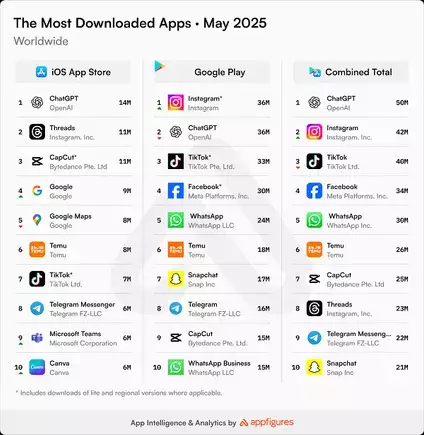In the rapidly evolving landscape of social media, few narratives echo as loudly as that of Threads. Meta’s attempt to carve a niche in the competitive realm of real-time communication platforms is not just about engaging the audience; it is a telling reflection of the changing tides in user behaviors and preferences. As of May, Threads captured the attention with 23 million downloads across both iOS and Android platforms, a slight yet significant increase from 22 million the month before. This uptick is indicative of a consistent trend where user engagement is not just consolidated but actively thriving.
The application now boasts an astonishing 350 million monthly active users, rapidly closing the gap on its closest competitor, X, which reported 600 million monthly users as of its last evaluation. However, a deeper analysis into X’s significant dip—15% in European usage—raises eyebrows regarding its actual growth narrative. The tightly controlled metrics by private companies like X often shield genuine user engagement, making Threads’ transparent growth all the more compelling and trustworthy.
Real-time News: Threads’ Secret Weapon
What sets Threads apart in this dog-eat-dog environment? The answer lies in its focused approach on real-time news and live-event enhancements. As the app steadily seeks to position itself as the go-to platform for in-the-moment engagement, it has successfully attracted users who crave timely information and interaction. By strategically enhancing its features to capture live events—importantly in the sports arena—Threads signifies a forward-thinking method of drawing in users who prioritize immediacy over the usual social media fluff.
The significance of these real-time features cannot be overstated. In a world where information is continuously bombarding users, the need for platforms that curate this noise into digestible, relevant news has never been more vital. Threads is seizing this moment, presenting itself as not merely a social app but a tool for a vibrant, engaged community.
Comparative Analysis: Snapchat’s Stagnation versus Other Giants
Diving deeper into the app ecosystem, it’s illuminating to compare Threads’ ascendance with Snapchat’s struggles. Though Snapchat remains a popular tool for younger demographics, it is plagued by a concerning inability to retain older users. This inherent limit is compounded by Threads, Instagram, TikTok, and even Facebook, all of which have eclipsed the billion-user benchmark. Snapchat’s position, while still within the top ten apps, begs the question: what steps is it taking to evolve alongside its audience?
Snapchat’s current statistics reveal 900 million monthly active users but only 460 million daily users, a stark contrast to the more consistent engagement seen in its competitors. The application is essentially caught in a feedback loop, continually drawing in new youths while sacrificing connection with older, potentially loyal users. As the dynamics shift in app usage, it’s high time for Snapchat to reassess its trajectory if it hopes to reclaim relevance in an ever-competitive market.
Threading the Needle: A Path Forward
Threads’ steady, upward trajectory is more than a stroke of luck; it is the result of keen attention to the needs of modern social media users. By prioritizing real-time engagement and enhancing interactive features, it has positioned itself not only as a viable alternative to X but as a necessary evolution in social connectivity.
Meta’s awareness of the necessity for instantaneous information has made Threads a natural choice for users disillusioned with platforms that may stagnate or fail to adapt. As X wrestles with internal challenges amidst chaotic changes in leadership and direction, it becomes increasingly clear that Threads is not merely another competitor but a harbinger of the new era in social media.
While the varied app landscape continues to evolve, the unmistakable rise of Threads signals a clear message: social media’s future is rooted in real-time interactions and genuine user engagement, and those who fail to adapt may find themselves lost in the wake of those who do.

